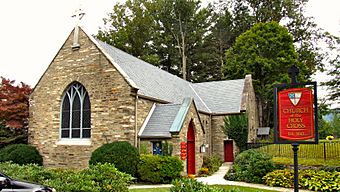Valle Crucis Episcopal Mission facts for kids
Quick facts for kids |
|
|
Valle Crucis Episcopal Mission
|
|
|
U.S. Historic district
Contributing property |
|

Church of the Holy Cross
|
|
| Location | NC 194 N side, 1 miles SW of jct. with NC 1112, near Valle Crucis, North Carolina |
|---|---|
| Area | 426 acres (172 ha) |
| Built | 1896 |
| Architectural style | Late Gothic Revival, Bungalow/Craftsman |
| NRHP reference No. | 93000938 |
| Added to NRHP | September 09, 1993 |
The Valle Crucis Episcopal Mission, also known as the Valle Crucis Conference Center, is a special historic place in North Carolina. It's a group of old church buildings and other important structures. This mission was started by the Episcopal Church between 1844 and 1845. It is located near a town called Valle Crucis in Watauga County, North Carolina.
Many of its buildings were built a long time ago. The beautiful Church of the Holy Cross, for example, was built around 1924. Other important parts include a church cemetery from 1808, the Auchmutv Hall dormitory from 1910-1911, and "The Farm House" from 1915. There's also "The Apple Barn" (once a dairy barn) and "The Bunk House" (once an apple barn). The Mission House dates back to 1896. Because of its history, the mission was added to the National Register of Historic Places in 1993. It is also part of the larger Valle Crucis Historic District.
Contents
Early Religious Community
In 1842, Bishop Levi Silliman Ives of the Episcopal Diocese of North Carolina started a religious group. It was called the Brotherhood of the Holy Cross. He wanted to create a place where Episcopalian men could live and pray like monks.
However, some of his ideas were seen as too similar to Roman Catholic teachings. This caused some disagreements within the Episcopal Church. Because of these issues, the "Brotherhood of the Holy Cross" was eventually closed down in 1849.
The first leader of this group was Reverend William Glenny French. He set up a strict daily schedule for everyone. They had religious services three times a day. Each man and boy also had to do two hours of manual labor every day. Father William also worked as a missionary. He held services for local mountain communities, including both free people and enslaved people.
William West Skiles, who was a brother and deacon, helped start this religious community.
Church of the Holy Cross
The first stone for the Church of the Holy Cross was placed in 1924. The church has a unique floor made of small, thick pieces of wood. These pieces were carefully fitted together like a puzzle. You won't find a floor quite like it anywhere else in the valley.
Inside the church, there is a special altar called the "Skiles Altar." It's a hand-carved wooden cupboard. This altar was given in memory of William West Skiles. He was a missionary brother from the Order of the Holy Cross. The altar was added to the church in the 1950s or 1960s.
Chapel of St. Anthony
The Chapel of St. Anthony is a small, quiet place at Valle Crucis. It is located among four small cabins called hermitages. These hermitages are designed for people who want a temporary retreat. They offer a peaceful space for renewal and reflection.
Artists, writers, educators, and people of many different faiths can use these cabins. The hermitages and the chapel form a small, separate community. The chapel has a hickory wood floor and a hand-carved altar. Local and custom artwork decorates its walls. This chapel is a perfect spot for quiet prayer, thinking, and spiritual guidance.
The Mission School
As part of the Episcopal mission, a school was created for local children. It was called the Classical and Agricultural School. This school taught not only regular subjects but also practical farming skills. It was one of the first schools in the state to teach agriculture.
One part of the school prepared boys to become ministers. One of its students was a black man named William Alston. He finished his studies in 1850 and later became an ordained minister in Philadelphia and New York. The school closed in 1850 when the mission was temporarily abandoned.
However, in 1895, the school reopened. It had an eight-room Mission House. This house provided a home for a teacher, another mission worker, and several boarding students. The school continued to operate into the 1990s. Girls who boarded at the school learned important home skills. These included milking, making butter, cooking, weaving, laundry, sewing, and embroidery.
Boys attended day classes. By 1900, the school had grown to 100 students, about half boys and half girls. Later, Bishop Junius Horner insisted that the school run a farm. This farm helped support the mission. He bought 525 more acres of land for the mission. Bishop Horner said the school was for "boys and girls who cannot take advantage of more expensive schools." By 1906, the farm raised over a thousand chickens. It also had over a hundred acres dedicated to apple trees.
Valle Crucis Turnpike
The Valle Crucis, Shaneehaw and Elk Park Turnpike was a private toll road. It was built between 1891 and 1892. Workers built it using only hand labor, without machines. A four-mile section of this road is famous for its winding curves. This section goes from the Valle Crucis Elementary School to Banner Elk, North Carolina. It is also known for its beautiful scenery. Today, parts of this old road are now part of North Carolina Highway 194.
Images for kids




